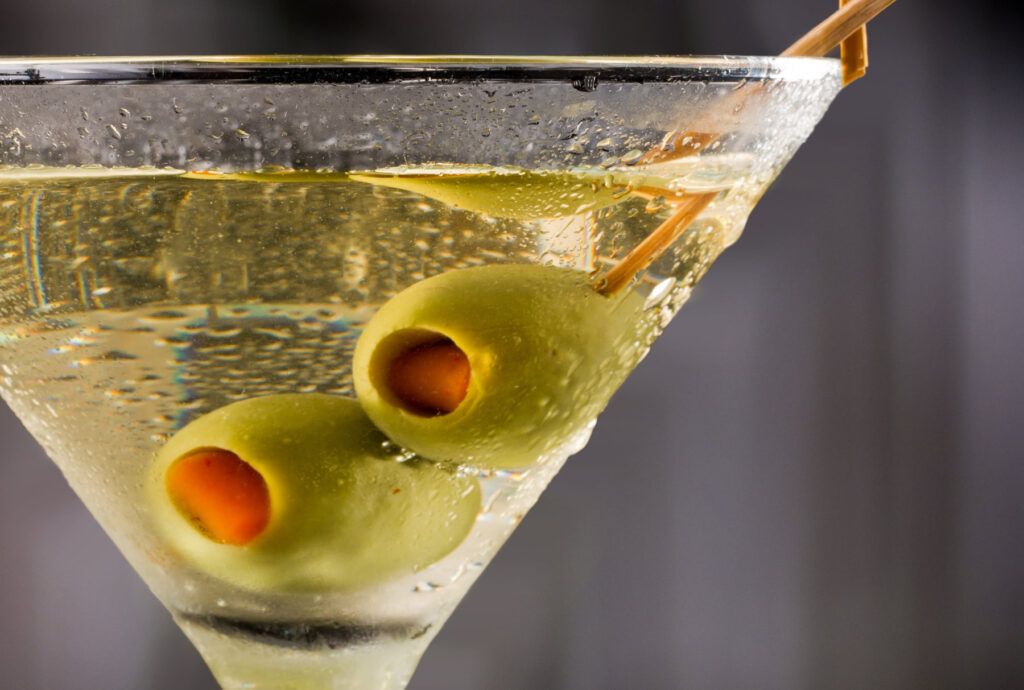Morley Scott might still be alive if only I’d known this fact sooner.
Okay, I’m being dramatic. Morley was always going to die. He is, or was, one of the main characters in my new time-travel/domestic thriller novel, TimeBlink, and although his grisly demise was preordained, I didn’t realize until today just how doomed a life I’d created for him.
Here’s the thing. Morley’s cocktail of choice had always been the classic martini. He was famously known among the staff at a popular pub in town to stroll in and order one, and only one, every time he visited. What’s more, he wanted it garnished no other way than with two pimento-stuffed olives skewered on a stick.
When I bestowed this preference on my ill-fated character, it was before I’d done any serious digging on what makes a good martini apart from what brand of gin to use—Boodles, if you were wondering; evidently the omission of citrus in the distilling process gives it a more neutral base flavor, which lends itself just as well to an olive garnish as to a twist of lemon.
The odds were stacked against poor Morley, I learned too late.
Indeed, today’s sleuthing uncovered the common superstition among bartenders that a martini should never, ever, be served with two olives (or four or six). That anything but an odd number of olives is a recipe for bad luck. And it made me wonder: If Morley had preferred his martinis with three olives instead of two, might I have spared him his untimely and horrific death?
Probably not. But now that I know this practice is on the bartender’s naughty list, it’s a shame I missed the opportunity to tie it into the storyline. Maybe it will come up in the sequel. Or maybe it’s better to let my readers connect the dots for themselves, at the very least the ones who can spot a proper cocktail when they see it.
Some like it dirty.
The variations on this popular cocktail are myriad, but Morley was a purist when it came to the way he liked his martini prepared. He never wanted it dirty (served with a dash of olive brine) and would quietly judge the uncultured sot who preferred vodka over gin. I may be painting him as a bit of a snob here, but really, he was just discerning, to the point where I’m sure he would have shuddered if he’d heard someone order a Vesper, a variation of the martini created in 1953 by none other than James Bond. More accurately, it was author Ian Fleming who came up with the formulation in his first Bond novel, Casino Royale. A staple on drink lists to this day, it contains both gin and vodka combined with Lillet Blanc, a fortified aromatic wine.
Should you shake a martini?
An emphatic no. Contrary to the other belief popularized by our illustrious British secret service agent, a martini is never shaken. It is gently stirred before being strained into a chilled glass. Shaking is to be reserved for drinks containing fruit juices, dairy, or honey to fully combine the ingredients as well as a way to incorporate air into the mixture. For this reason, true connoisseurs say that shaking fine spirits is not only unnecessary but also mildly destructive as it is believed the practice can actually “bruise” the texture of fine spirits. That being said, I imagine it would take an especially astute palate to be able to tell the difference.
So, without further ado, I give you the Classic Martini the way Morley liked it.
Ingredients:
Ice
2 ½ ounces good quality London dry gin
1 Tbsp dry vermouth
1 or 3 olives
To a chilled martini glass, add the vermouth and swirl it around a couple of times, then pour it out. Yes, down the sink, not into your mouth! This step will serve to scent the glass and ensure the driest martini possible.
Half-fill a mixing glass with ice. Add gin and stir just long enough to chill the gin, no more than 60 seconds. Strain it into the prepared martini glass.
Garnish with one or three Spanish olives stuffed with a pimento. For a refined touch, spear them with a cocktail pick and balance it on the rim of the glass to one side or submerge it in the drink completely. If you prefer a more casual presentation, plop those olives right into the glass loose and fancy-free.
Martini, anyone?
With all this chitter-chatter about what is arguably the world’s most sophisticated cocktail, it’s made me want one. Right now. Sure, it may be 1:00 in the afternoon, but didn’t there used to be a saying about a two-martini lunch? Or was it three? Do businesspeople still get together for drinks and swanky steak and lobster meals in the middle of the day? I hope so! Sounds like something I’d like to give a whirl.
So what about you? Do you have a favorite martini recipe? Share it here! And while you’re at it, let us know how many olives you prefer…if it’s two, I wish you the best of luck. 😉

You can lace the martini glass with scotch and barely introduce the vermouth to the gin. I prefer 3 garlic or blue cheese stuffed olives. It doubles as an appetizer that way! 😉
I like the way you think, Angela. 🍸 Cheers!
Thanks for this! If I find where the ‘never two olives’ requirement originated, I’ll let you know. In the meantime do you know why lunchtime martinis are like breasts? Because one isn’t enough, and three’s too many. Cheers!
Ha! Thanks for the giggle, Jeremy. Glad the article sparked your interest. 🙂